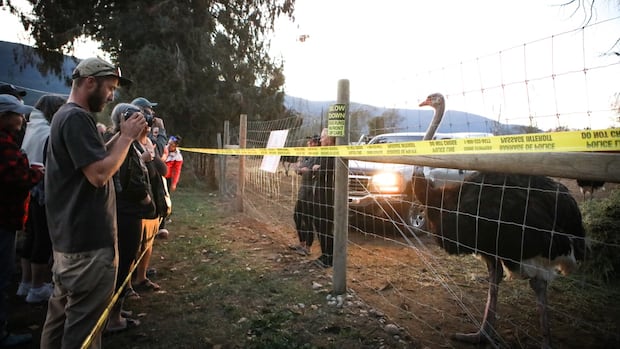The tension between hundreds of protesters, RCMP officers and Canadian Food Inspection Agency (CFIA) workers has come to a standstill after the Supreme Court of Canada issued a temporary stay of an order to kill more than 300 ostriches at a farm in the remote B.C. Interior community of Edgewood, about 95 kilometres east of Kelowna.The court ordered the stay on Wednesday as the CFIA was setting up to carry out a cull order, after avian flu was discovered in the flock in December 2024. All action at the Universal Ostrich Farms is now paused.The complex story of how the farm’s owners have fought for the lives of their ostriches has generated international attention over things like Canada’s avian influenza management protocols and claims of government overreach — compounded by the unique scenario of the outbreak and the animals’ survival.Here are the answers to some questions our readers have been asking.If you’re looking for more detailed answers, CBC News also has an in-depth explainer.Ostriches eat their feed at the Universal Ostrich Farms in Edgewood, B.C., on Saturday, May 17, 2025. (Aaron Hemens/The Canadian Press)Wait, there’s an ostrich farm in B.C.? There are actually several ostrich farms located across the province. Ostriches are considered poultry by the B.C. government.The Universal farm, run by business partners Karen Espersen and Dave Bilinski, began as a meat-sale operation more than 30 years ago, selling ostrich meat, eggs and oil.WATCH | Ostrch farm fights CFIA order: Why a B.C. ostrich farm is fighting a cull order from the CFIAA last-minute reprieve for the ostriches of Edgewood, B.C., has left the fate of the birds in limbo. The Canadian Food Inspection Agency remains in control at the farm, with the farm’s supporters holding out hope that the Supreme Court of Canada will decide to hear the case. CBC’s Brady Strachan explains how we got here and some of the reasoning from both sides.The farm’s website says it moved away from that industry and now focuses on breeding, tourism and research. The timeline of this transition is unclear.CFIA says the farm has not provided any documentation outlining the research it claims to carry out. It also says the farm lacks facilities “suitable for controlled research activity or trials.”Dr. Scott Weese, a professor, researcher and veterinarian from the University of Guelph in Ontario, told CBC News he has not found any evidence the farm has received formal research or scientific animal care approval from a recognized regulatory body.What is avian flu and how did the ostriches become infected?Avian flu, also known as H5N1, is a respiratory illness that is largely transmitted through wild birds. According to the U.S. Centre for Disease Control, the disease can also spread to mammals, including wild animal, livestock and humans.This colourized electron microscope image released by the National Institute of Allergy and Infectious Diseases on March 26, 2024, shows avian influenza A H5N1 virus particles (yellow) grown in Madin-Darby Canine Kidney (MDCK) epithelial cells (blue). (CDC/NIAID/The Associated Press)The farm said it had 450 ostriches at the beginning of December 2024.Weeks later, a flock of wild ducks landed in the ostrich’s open air enclosure. In the days and weeks that followed, 69 of the farm’s youngest birds died after contracting a respiratory infection, said the CFIA.An anonymous source reported the deaths to the CFIA, as the farm did not self-report. CFIA then imposed a quarantine order and visited the farm to collect samples from two of the dead birds.On Dec. 31, Universal was told the tests for avian flu were positive, and an order to cull the remaining flock was issued.What is a cull order and why would the surviving ostriches be killed?CFIA says it takes the management of avian flu seriously in order to keep humans and wild and domestic animals safe — as well as the country’s $6.8-billion poultry industry and international trade relations.CFIA employs the “stamping out” policy outlined by the World Organization for Animal Health, which requires all animals in a flock to be killed, even if H5N1 is detected in just one bird.Katie Pasitney embraces her mother, Karen Espersen, at Universal Ostrich Farm in Edgewood, B.C., after learning the Supreme Court of Canada had granted a temporary stay order halting the cull of their flock, on Wednesday, Sept. 24, 2025. (CBC News)The killing of a farm’s livestock in response to a disease is called a cull. In commercial operations, owners of livestock — including cattle, swine and poultry — are eligible for compensation for the cost of the animal and associated expenses.Countries that do not comply with internationally recognized biosecurity standards may be prohibited from engaging in commercial trade of animal products.Chickens are pictured at a large poultry farm that was flooded in Abbotsford, British Columbia on Friday, December 10, 2021. (Ben Nelms/CBC)Countries and provinces regularly ban the import of poultry products from jurisdictions facing avian flu outbreaks. Nine regions in Canada, including B.C., are currently subject to such sanctions by the U.S. Department of Agriculture, meaning poultry and avian products or byproducts originating from restriction zones cannot be imported into the U.S.In 2025, millions of domestic birds from farms across Canada were killed as part of cull orders from the CFIA, in accordance with the criteria for avian flu outlined by the World Organization for Animal Health. A number of Mounties were on hand Monday, Sept. 22, 2025, as a search warrant was served to owners and supporters of Universal Ostrich Farm in Edgewood, B.C. (Curtis Allen for CBC)Culls are typically carried out by farmers themselves or by hired contractors. When a cull order is not followed, the CFIA will step in to execute the order.CFIA lists compensation of $3,000 per ostrich, but warns the money may be withheld if it has to conduct the cull itself.Emotions were elevated at Universal Ostrich Farm in Edgewood, B.C., on Monday, Sept. 22, 2025, as the Canadian Food Inspection Agency and police attended the farm with a search warrant. (Curtis Allen for CBC)How would the ostriches be killed?CFIA will not provide details of how the cull will take place, but has stated it will be “humane.”Typically, on commercial poultry operations where chickens or turkeys are raised, a method of oxygen deprivation is used to kill or stun the birds. This typically involves the use of carbon dioxide. Most animal respiratory systems do not recognize there is an oxygen shortage when carbon dioxide is present. Eventually, the lack of oxygen causes the animal to become unconscious and eventually die.Camille Labchuk, a lawyer with Animal Justice, said large birds like ostriches are often killed using captive bolt pistols. She fears, if this method is used in the cull of the ostriches, it will cause undue stress.”When animals are killed off by the CFIA because of disease risks, rules are abridged and the CFIA has very broad discretion,” said Labchuk.Why won’t the government re-test the surviving ostriches? The owners and supporters of the Universal farm have demanded the CFIA re-test the surviving birds for avian flu. The farm asserts the birds have developed “herd immunity” and would be resistant to future infections. Assessing a flock for H5N1 infection is done by gathering a sample from a bird’s mouth, nose or cloaca — an orifice that acts as a vagina, urethra and anus — and analyzing it with polymerase chain reaction testing. The samples must be taken to a specialized containment laboratory for analysis in order for the results to be reliable, according to the federal government.Angela Rasmussen, a professor and researcher of virology at the University of Saskatchewan, said even if the farm’s surviving birds were tested, older ostriches often do not develop antibodies against viruses like avian flu, meaning the tests cannot reliably determine whether or not the birds have immunity to H5N1.”Simply having antibodies does not guarantee immunity to H5N1,” Rasmussen told CBC News.This means the birds may still be a vector for disease and could transmit or contract avian flu from wild birds, she said. The CFIA has refused to test the surviving birds, while the farm and its supporters say they have been threatened with fines and jail time if they conduct their own testing. The Health of Animals Act states penalties could apply if a person disobeys CFIA orders, with maximum fines up to $50,000 and six months in jail on a summary conviction, or up to $250,000 and two years in jail on indictment. CFIA’s biosecurity orders restrict the removal of any ostrich material from the property, including samples for testing, as the farm is currently quarantined in a containment zone.WATCH | RCMP at Universal Ostrich Farms: RCMP gather at B.C. ostrich farm facing cullRCMP have gathered in Edgewood, B.C., to support the Canadian Food Inspection Agency as it executes a search warrant at the Universal Ostrich farm, where approximately 400 birds have been ordered killed due to avian flu concerns.Why is there so much opposition, if culls are not unusual in the poultry industry?Since last December, the farm and its supporters have been fighting the cull order through the courts, through a social meida awareness campaign and via the media. Thousands of people from around the world have donated to their online fundraiser and have called on Canadian government officials to save the ostriches.The battle has attracted hundreds of people to the farm, with many camping out. The issue of the cull has become a vector for those concerned about perceived government overreach, or those who don’t trust government organizations and mandates used to contain viruses.Notable voices from the U.S. — including TV host and now administrator Dr. Mehmet Oz, Health Secretary Robert F. Kennedy, Jr., and billionaire John Catsimatidis — have publicly urged Canadian officials to allow the ostriches to live.
B.C. ostrich cull: Answering your questions after Supreme Court of Canada’s reprieve











